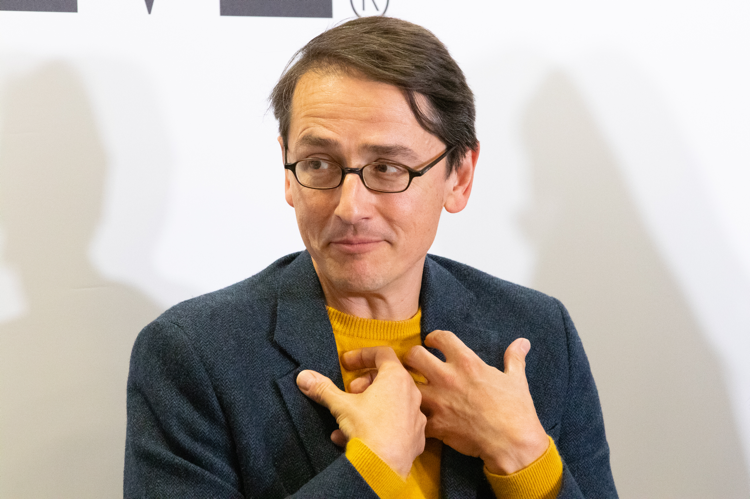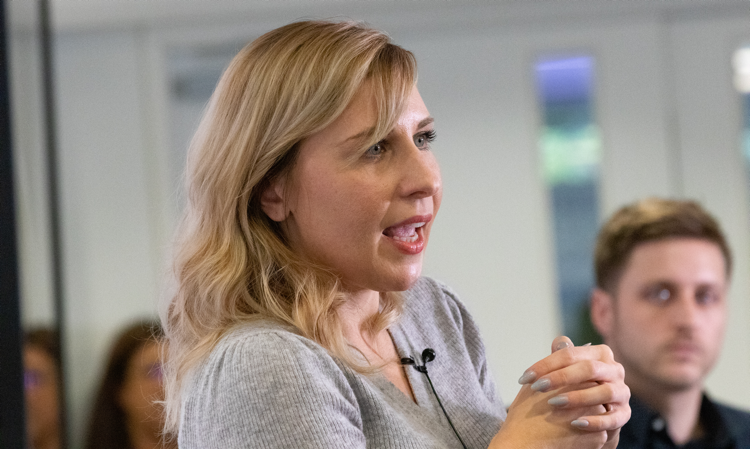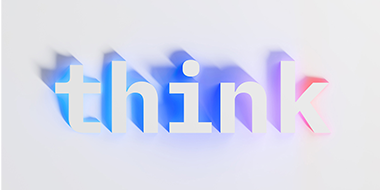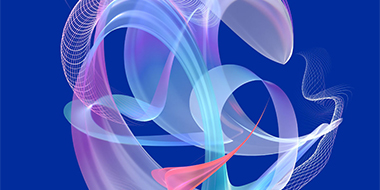About cookies on this site Our websites require some cookies to function properly (required). In addition, other cookies may be used with your consent to analyze site usage, improve the user experience and for advertising. For more information, please review your options. By visiting our website, you agree to our processing of information as described in IBM’sprivacy statement. To provide a smooth navigation, your cookie preferences will be shared across the IBM web domains listed here.
Artificial Intelligence
Artificial Intelligence to Create Art
20 December, 2019 | Written by: Samuel Fry
Categorized: Artificial Intelligence | IBM Events UK - Blog
Share this post:
Reflections on the Artists on Artificial Intelligence event, run by Lumen Art Projects at IBM Southbank on how to use artificial intelligence to create art.
When technologists and artists challenge each other, we build more innovative experiences. This was the reason that IBM recently hosted a Lumen Art Projects event called ‘Artists on Artificial Intelligence’ – a day of discussion, debate and demos from artists working with AI.
The event brought together a number of digital artists, who each spoke about their experiences. The artists included Dave Murray-Rust, Rocio von Jungenfeld, Mario Klingemann and Maja Petric. Then, to close the event, I facilitated a panel discussion with all of them plus Tracey Gilbert, IBM iX Leader for UK and Ireland. Together we reflected on the process of creating art with technology. I would like to use this blog to share some of those reflections.

Mario Klingemann, speaking at the ‘Artists on Artificial Intelligence’ event at IBM Southbank.
A balance between control and entering the unknown
Often, we talk about artificial intelligent systems working alongside people, to help augment their knowledge. This is just as relevant to artists that work with technology as it is to any business. So, as you might expect, this topic was regularly discussed throughout the day. One of the speakers from the day was Mario Klingemann, a German artist and Google Arts and Culture resident. He is considered a pioneer in using computer learning in the arts and has appeared at Ars Electronica Festival, the Museum of Modern Art New York and recently at the Barbican as part of their ‘AI: More than Human‘ exhibition.
In his talk, Mario described himself as an ‘image trapper’ rather than an ‘image creator’. This is because his artistic process involves him developing neural networks that create thousands of images and then he manually reviews those images to select the images that resonate with him.
For Mario, working with an Artificial Intelligence (AI) means entering the unknown. He creates the rules for the neural network to follow but he then gives it the freedom to create. During the talk he referenced a statement from Francis Bacon, who spoke about exploiting the ‘creative accident’ by saying that ‘my ideal would really be just to pick up a handful of paint and throw it at the canvas and hope that the portrait was there.’ Mario believes that neural networks can create new artefacts but it needs a ‘critical sense’ to find the art.
Bringing technology to life
The relationship between humans and technology came up in other discussions too.
Another speaker was Dr Dave Murray-Rust. Dave is a Lecturer in Design Informatics at the University of Edinburgh. His research focuses on the interesting ‘messy bits’ between people and computational systems, from large scale Social Machines through the Internet of Things to Personal Data and privacy.
Dave is interested in how to allow technology to ‘push back’ and he does this by making it appear to be animate. One way that he achieves this illusion is through designing technology that purposely deceives us. For instance, he created a system that shares our wrong location to other tracking technologies and another system which fills your calendar with incorrect meetings. The reason is to explore the relationship between people and machines.
Dave spoke in particular about his project Lichtsuchende. Lichtsuchende is an interactive installation of robotic creatures that appear to communicate with light. He collaborated on the project with another speaker from the event, Rocio von Jungenfeld. Lichtsuchende is an example of where artists are making robotic technology appear to be alive by creating the illusion that it is responding to the people around them. When the light changes, for instance when someone shines a torch, the robots move.
The Lichtsuchende project is described by Dave as ‘a society of robotic sunflowers’; yet, what this technology allows us to understand is how our society might work with robots in the future. Rocio explained that she had interviewed some participants that have interacted with the Lichtsuchende project. The participants described them as ‘creaturely’ and ‘ephemeral’, which shows how our perception of technology might change in the future as technology appears to be more alive.
Maja Petric, another artist speaker at the event talked about her work as using ‘light and space to really engage people’s emotions and imagination’. Much of Maja’s work uses light to create immersive art experiences. She uses technology to change people’s perception of the world they are in by mimicking natural light effects.

Maja Petric, speaking at the ‘Artists on Artificial Intelligence’ event at IBM Southbank.
Humans like categories; neural networks see the world as one continuous space
The artists also discussed their interest in reviewing how technology interprets the world. In Mario’s talk, he explained that humans like to categorise things but that neural networks look at the world as one continuous space.
Mario gave the example of ‘latent spaces’. He explained that a latent space occurs when you visualise how a neural network analyses information. For instance, as he put it in his talk, ‘when you train a model to recognise something like a dog and a tree’ then ‘the model shapes that space’ as vector where ‘all the dogs end up in a certain area’ of that vector and trees would end up somewhere else. In a similar way, if you taught it what a cat was, those cats would have their own space. What is interesting is when you look at how the model makes connections between cats and dogs as ‘it learns that cats and dogs have something in common, like eyes and ears and fur’. Seeing that information, helps artists like Mario understand how technology interprets the world. As he puts it, ‘we can get a glimpse of how a machine views the world and how we see the world. That exploration is really fascinating.’
Often, in business we use technology to automate processes or make certain experiences more seamless. We look at other industries and best practice for idea on how to do this. Yet, we don’t often look at how technology understands the world and that could be another perspective to consider.
Collaborating with artists
At the beginning of this post, I wrote that when technologists and artists challenge each other, we build more innovative experiences. This event has only gone to strengthen my view that this is the case.
Artists may approach technology from a different perspective, or with a different goal; yet, by working closer with each other I believe we can influence each other. This is something that Dave Murray-Rust explained in the closing words to his talk, where he said that ‘we can use artistic practice to allow people that are working with artificial intelligence to rethink what they are doing’.
So, wherever you are working with technology, why not work more with artists, or academics, or scientists, historicists, philosophers and other groups. As perhaps, those conversations will lead to something even more innovative.
An overview of the event, including some of the talks, can be heard on the TECHnique podcast.
Banner Image courtesy of Maja Petric.

Samuel Fry
Managing Consultant - IBM iX
More Artificial Intelligence stories
By Nicola Hodson on 26 September, 2023
Unleash the Power of AI: Join Think on Tour London 2023
The world is captivated by the incredible possibilities of Generative AI (Artificial Intelligence). It is reshaping industries, sparking discussions, and defining a new era of technological advancement. AI is not just a buzzword; it is already on the agenda in every boardroom and businesses in all sectors are looking to harness the potential AI. Organisations […]
By Rachel Allinson on 5 May, 2021
Managing Unprecedented Workloads in 2020’s Market Volatility
Managing Unprecedented Workloads in 2020’s Market Volatility. 2020 was a challenging year for all of us, for many differing reasons, but it was certainly not a year of standing still for most organisations, in fact many businesses saw previous trends accelerate in 2020. In a recent study McKinsey found “responses to COVID-19 have speeded the […]
By Sreeram Visvanathan on 5 October, 2020
Post-pandemic thinking: how industries can break out of survival mode
The pandemic continues to dominate news headlines around the world. The ongoing pressures of the health crisis emphasise how critical remote working, business agility and digital customer engagement are to business. Business leaders the world over are reflecting on the need to build resiliency, flexibility and agility into their organisations (I explore some of my […]





























